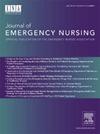Oral Syringe Versus Drug Pacifier for Delivery of Oral Antipyretic Medication: A Randomized Controlled Trial
IF 2.3
4区 医学
Q2 EMERGENCY MEDICINE
引用次数: 0
Abstract
Introduction
Fever is 1 of the most common symptoms in children, and oral paracetamol is 1 of the most preferred antipyretic and analgesic agents for treating fever. Administering the full dose is key to effectively managing symptoms, which necessitates a method to prevent dose loss. This study compared 2 different drug delivery methods used for oral paracetamol administration in terms of clinical efficacy.
Methods
After obtaining ethical approval, the study was conducted with 100 eligible children aged 0 to 24 months who presented to a university hospital pediatrics department between January 2021 and February 2022. The children were randomly assigned to the drug pacifier (n = 50) and oral syringe groups (n = 50). Data were collected using a patient information form and the Face, Legs, Activity, Cry, and Consolability pain scale. Vital signs were recorded before and 15, 30, 45, and 60 minutes after drug administration. In addition, Face, Legs, Activity, Cry, and Consolability pain scores were recorded by a parent, researcher, and nurse observer at the same time points. The observer nurse also noted any spillage of the drug during oral administration by the nurse to the children in both groups. (Clinical Trial Registry: NCT05366049)
Results
There was no significant difference between the groups in terms of body temperature before or after drug administration (P>.05). Heart rate and respiratory rate were significantly lower in the drug pacifier group starting at minute 30 (P<.05). Oxygen saturation was significantly higher in the drug pacifier group from minute 45 (P = .001). In pain comparisons, there was no significant difference between the groups in the mean scores given by the parent, nurse observer, and researcher before drug administration, whereas the drug pacifier group had statistically significantly lower pain scores than the oral syringe group at all post-drug administration time points (15, 30, 45, and 60 minutes) (P<.05). Interobserver agreement was high at all measurement times.
Discussion
Using a drug pacifier for paracetamol, drug administration was more effective in delivering the target drug dose. Given the higher dose accuracy and positive effect on vital signs, we recommend using the drug pacifier in very young children.
口服注射器与药物安抚奶嘴的比较:一项随机对照试验。
发热是儿童最常见的症状之一,口服扑热息痛是治疗发热最常用的解热镇痛药之一。给予全剂量是有效控制症状的关键,这就需要一种防止剂量损失的方法。本研究比较了口服扑热息痛两种不同给药方式的临床疗效。方法:在获得伦理批准后,对2021年1月至2022年2月期间在某大学医院儿科就诊的100名年龄在0至24个月的符合条件的儿童进行研究。将患儿随机分为药物安抚奶嘴组(n = 50)和口服注射器组(n = 50)。使用患者信息表和面部、腿部、活动、哭泣和安慰性疼痛量表收集数据。记录给药前及给药后15、30、45、60分钟的生命体征。此外,面部、腿部、活动、哭泣和安慰性疼痛评分由家长、研究人员和护士观察员在同一时间点记录。观察护士还注意到两组儿童在口服给药过程中是否有药物溢出。(临床试验注册号:NCT05366049)结果:两组患者给药前后体温差异无统计学意义(P < 0.05)。从第30分钟开始,药物安抚奶嘴组的心率和呼吸频率明显降低(p讨论:对扑热息痛使用药物安抚奶嘴,药物给药更有效地传递目标药物剂量。考虑到更高的剂量准确性和对生命体征的积极影响,我们建议在非常年幼的儿童中使用药物安抚奶嘴。
本文章由计算机程序翻译,如有差异,请以英文原文为准。
求助全文
约1分钟内获得全文
求助全文
来源期刊
CiteScore
3.10
自引率
11.80%
发文量
132
审稿时长
46 days
期刊介绍:
The Journal of Emergency Nursing, the official journal of the Emergency Nurses Association (ENA), is committed to the dissemination of high quality, peer-reviewed manuscripts relevant to all areas of emergency nursing practice across the lifespan. Journal content includes clinical topics, integrative or systematic literature reviews, research, and practice improvement initiatives that provide emergency nurses globally with implications for translation of new knowledge into practice.
The Journal also includes focused sections such as case studies, pharmacology/toxicology, injury prevention, trauma, triage, quality and safety, pediatrics and geriatrics.
The Journal aims to mirror the goal of ENA to promote: community, governance and leadership, knowledge, quality and safety, and advocacy.

 求助内容:
求助内容: 应助结果提醒方式:
应助结果提醒方式:


